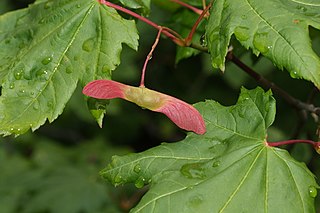
A samara is a winged achene, a type of fruit in which a flattened wing of fibrous, papery tissue develops from the ovary wall. A samara is a simple dry fruit, and is indehiscent. The shape of a samara enables the wind to carry the seed further away from the tree than regular seeds would go, and is thus a form of anemochory.

Fraxinus, commonly called ash, is a genus of plants in the olive and lilac family, Oleaceae, and comprises 45–65 species of usually medium-to-large trees, most of which are deciduous trees, although some subtropical species are evergreen trees. The genus is widespread throughout much of Europe, Asia, and North America.

Fraxinus americana, the white ash or American ash, is a fast-growing species of ash tree native to eastern and central North America.
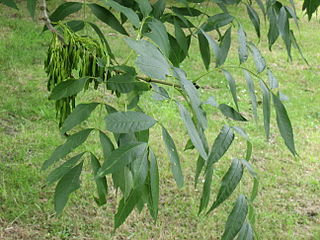
Fraxinus excelsior, known as the ash, or European ash or common ash to distinguish it from other types of ash, is a flowering plant species in the olive family Oleaceae. It is native throughout mainland Europe east to the Caucasus and Alborz mountains, and west to Great Britain and Ireland, the latter determining its western boundary. The northernmost location is in the Trondheimsfjord region of Norway. The species is widely cultivated and reportedly naturalised in New Zealand and in scattered locales in the United States and Canada.

Fraxinus pennsylvanica, the green ash or red ash, is a species of ash native to eastern and central North America, from Nova Scotia west to southeastern Alberta and eastern Colorado, south to northern Florida, and southwest to Oklahoma and eastern Texas. It has spread and become naturalized in much of the western United States and also in Argentina and Europe, from Spain to Russia.

Fraxinus angustifolia, the narrow-leaved ash, is a species of Fraxinus native to Central Europe and Southern Europe, Northwest Africa, and Southwest Asia.

Fraxinus lanuginosa is a species of ash native to Japan and to the Primorye region of eastern Russia.

Melia is a genus of flowering trees in the family Meliaceae. The name is derived from μελία, the Greek name used by Theophrastus for Fraxinus ornus, which has similar leaves.

Fraxinus floribunda is a species of ash native to South Asia, East Asia, and Southeast Asia. It is known from Afghanistan, Pakistan, Nepal, Assam, Bhutan, Laos, Myanmar (Burma), Thailand, Vietnam, the Ryukyu Islands, and parts of China.

Fraxinus uhdei, commonly known as tropical ash or Shamel ash, is a species of tree native to Mexico and Central America. It is commonly planted as a street tree in Mexico and the southwestern United States. It has also been planted and spread from cultivation in Hawaii, where it is now considered an invasive species.

Fraxinus malacophylla is a species of ash tree in the family Oleaceae. It is native to China, where it is found in Guangxi and Yunnan provinces, and Thailand.
Dasineura acrophila is a gall midge which forms galls on the leaves of ash. It was first described by Johannes Winnertz in 1853 and is found in Europe.
Fraxinus bungeana is a species of flowering plant belonging to the family Oleaceae.
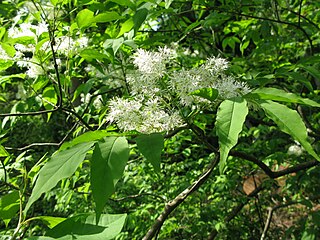
Fraxinus sieboldiana, the Chinese flowering ash or Japanese flowering ash, is a species of flowering plant in the family Oleaceae. It is native to southeastern China, the Korean peninsula, and Japan. It grows on wooded slopes and by streams. It is hardy to USDA zone 6. A variegated cultivar, 'Rising Sun', is available.
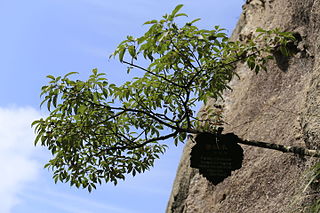
Fraxinus insularis, the Chinese flowering ash or island ash, is a species of flowering plant in the family Oleaceae, native to central and southeastern China, Hainan, Taiwan, the Ryukyu Islands, and Yakushima, Japan. Its leaves produce a number of secoiridoid glucosides.
Fraxinus longicuspis, the taper-tip ash or Japanese ash, is a species of flowering plant in the family Oleaceae, native to the mountains of central and southern Japan. A deciduous tree, it is hardy to USDA zone 5. It is used as a street tree in a few cities around the world.

Fraxinus platypoda, the Chinese red ash, is a species of flowering plant in the family Oleaceae, native to central China, and Japan. In the latter stages of succession it often dominates the mountain riparian forest habitat in which it is found.
Fraxinus greggii, the littleleaf ash or Gregg's ash, is a species of flowering plant in the family Oleaceae, native to Texas and Mexico. A xerophytic shrub or scrubby tree reaching 6 m (20 ft), it is suitable for screens and containers. There is a cultivar, 'Libby Davison'.
Fraxinus chiisanensis, the Jirisan ash, is a species of flowering plant in the family Oleaceae, native to South Korea. With only about 20,000 mature trees found in nine locations, it is assessed as Endangered due to severe population fragmentation, and some logging pressure. In spite of its Endangered status, it is still dominant in those streamside mountain forests where it does occur.
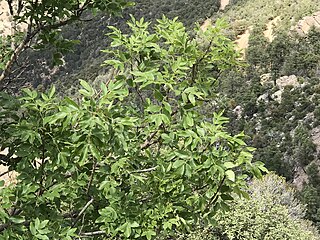
Fraxinus papillosa, the Chihuahuan ash, is a species of flowering plant in the family Oleaceae, native to the deserts of Mexico and the southwestern United States. A small tree, it usually is found growing in canyon bottoms and on north-facing slopes.














